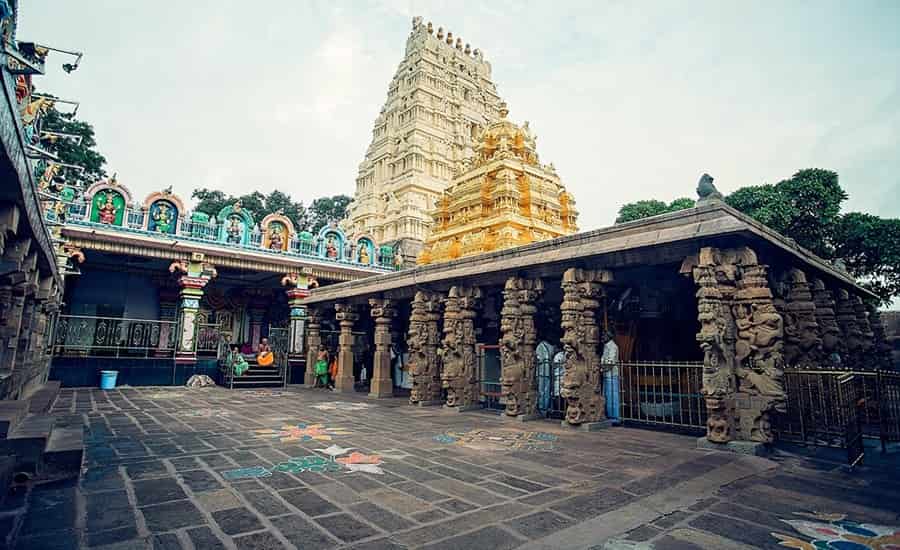History and Architecture of Sri Mallikarjuna Swamy Temple
The Sri Mallikarjuna Swamy Temple, located in Srisailam, Andhra Pradesh, India, stands as a testament to the rich history and architectural brilliance of Hindu temple construction. Dedicated to Lord Shiva, who is worshiped here in the form of Mallikarjuna Swamy, this temple has a history that spans centuries and boasts a distinctive architectural style that reflects the cultural and religious ethos of the region.
Historical Background
The temple's origins are traced back to the time of the Satavahana dynasty, which ruled the region around the 2nd century BCE to the 2nd century CE. Over the centuries, various dynasties, including the Chalukyas, Kakatiyas, Vijayanagara Empire, and the Bahmani Sultanate, have contributed to the temple's development and expansion. Each ruler left an indelible mark on the temple, resulting in a harmonious blend of architectural styles.
Architectural Marvels
The Sri Mallikarjuna Swamy Temple showcases a unique architectural style that evolved over different periods of its existence. The temple complex is a sprawling structure with various halls, shrines, and intricate carvings, offering a visual treat to visitors.
Raja Gopuram
The temple's entrance is marked by a towering Raja Gopuram, a monumental tower adorned with intricate sculptures and carvings depicting various mythological scenes. This Gopuram serves as a grand welcome to the pilgrims and sets the tone for the architectural marvels within.
Mukha Mandapa
Upon entering the temple, visitors are greeted by the Mukha Mandapa, a spacious hall adorned with pillars featuring ornate carvings. This area serves as a congregation space for devotees and is often used for cultural events and religious ceremonies.
Artha Mandapa and Maha Mandapa
Moving further into the temple, one encounters the Artha Mandapa and Maha Mandapa, which are additional halls featuring exquisite architectural details. The pillars in these halls are known for their unique designs, showcasing the artistic brilliance of the craftsmen of that era.
Sanctum Sanctorum
The main sanctum, housing the lingam of Mallikarjuna Swamy, is the focal point of the temple. The sanctum is adorned with intricate carvings, and the lingam is the object of veneration for millions of devotees who visit the temple seeking the blessings of Lord Shiva.
Sculptures and Bas-Reliefs
Throughout the temple complex, one can find a plethora of sculptures and bas-reliefs depicting various Hindu deities, mythological stories, and celestial beings. These artistic representations not only add to the aesthetic appeal of the temple but also serve as a medium for conveying religious and moral teachings.
Renovations and Restoration
The Sri Mallikarjuna Swamy Temple has undergone several renovations and restoration projects over the centuries. These efforts were initiated by rulers and philanthropists who sought to preserve the sanctity and architectural grandeur of the temple. The Chalukyas, Vijayanagara kings, and later dynasties have contributed significantly to the maintenance and enhancement of the temple complex.
In recent times, various governmental and non-governmental organizations have taken up the responsibility of preserving and restoring the temple. The meticulous restoration work aims not only to repair the wear and tear caused by the passage of time but also to maintain the authenticity of the original architectural elements.
Religious Significance
The Sri Mallikarjuna Swamy Temple holds immense religious significance for Hindus, especially devotees of Lord Shiva. Pilgrims from across the country undertake arduous journeys to seek the blessings of Mallikarjuna Swamy, believed to be a form of Lord Shiva that grants salvation and fulfillment of wishes.
The temple is also associated with various legends and myths, adding to its mystique. The sacredness of the location, surrounded by the natural beauty of the Nallamala Hills and the Krishna River, further enhances the spiritual experience for the devotees.
Conclusion
The Sri Mallikarjuna Swamy Temple stands as a living testament to the enduring legacy of Hindu temple architecture and spirituality. Its rich history, diverse architectural styles, and religious significance make it a jewel in the cultural heritage of India. As pilgrims continue to flock to this sacred site for the Mallikarjuna Swamy Temple tour, the temple remains not only a place of worship but also a symbol of the profound connection between art, history, and faith. The enduring appeal of the Sri Mallikarjuna Swamy Temple is a testament to the timelessness of India's cultural and religious heritage.

Comments
Post a Comment